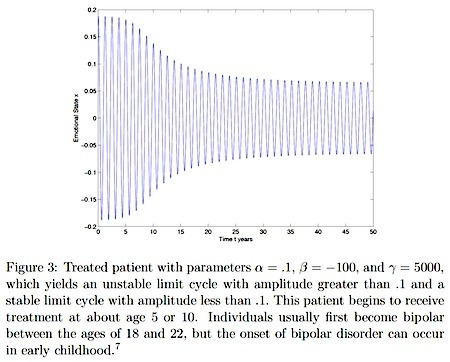Marc Abrahams's Blog, page 408
April 29, 2014
First attempts to model bipolar patients as harmonic oscillators
People with bipolar disorder swing between mood extremes. A team of mathematicians decided to see how much of that swinging they could describe mathematically.
Mason Porter, then at the Georgia Institute of Technology and now at Oxford University, with several US colleagues, published a study in 2009, Mathematical Models of Bipolar Disorder. It appeared in the journal Communications in Nonlinear Science and Numerical Simulation.
Bipolar disorder has always been a difficult condition to recognise and describe in words, let alone equations….
—So begins this month’s Improbable Research column in The Guardian.
BONUS: Here’s detail from the study:

A ridiculously simple and explicit implicit function theorem
 The author of this paper about a ridiculously simple and explicit implicit function theorem has a history which you might enjoy looking up:
The author of this paper about a ridiculously simple and explicit implicit function theorem has a history which you might enjoy looking up:
“A ridiculously simple and explicit implicit function theorem,” Alan D. Sokal, Séminaire Lotharingien de Combinatoire, 61 (2009): B61Ad.
BONUS (unrelated): The other Sokal affair

April 28, 2014
(Video of) A measure of improbability at NIST
Here’s video of the colloquium talk I did a few days ago at NIST, the National Institute of Standards and Technology, in Gaithersburg Maryland. The official description: “A Measure of Improbable Research — haphazardly selected samples of Ig Nobel Prize-winning and other research that makes people LAUGH then THINK”. The talk was broadcast live to NIST facilities in Boulder, Colorado and Charleston, South Carolina. The event also featured Ig Nobel Prize winner Theo Gray, inventor of the 4-legged periodic table table, and Ted Doiron, the NIST scientist who co-authored (with his son, who at the time was a high school student) the only study ever performed to assess the metrology of complimentary small plastic rulers.

The MAFFIA mathematicians
Sensing that some things simply don’t add up, certain mathematicians have banded together to alert the public. Their web site explains:
Mathematicians Against Fraudulent Financial and Investment Advice (MAFFIA)
This site was created out of growing concern with the usage of less-than-fully rigorous mathematical and statistical methodologies in the financial/investment world….
We are also concerned with the proliferation of quasi-mathematical investment advice and financial columns in the past few years, which appear to be based on sophisticated mathematics and statistics, but which, upon more rigorous analysis, are at best questionable. We encourage the reader to search the Internet for terms such as “stochastic oscillators,” “Fibonacci ratios,” “cycles,” “Elliot wave,” “Golden ratio,” “parabolic SAR,” “pivot point,” “momentum,” and others in the context of finance. Although such terms clearly evoke precise mathematical concepts, in fact, in almost all cases, their usage is at best scientifically unsound….
Our approach here is not one of confrontation, but instead one of research to better understand and mitigate these difficulties, education to assist other professionals in the field, together with unbiased testing and analysis. If you identify with our concerns, let us know and spread the word. Together we can make a difference.
One of their alerts takes the form of a paper:
“Pseudo-Mathematics and Financial Charlatanism: The Effects of Backtest Overfitting on Out-of-Sample Performance,” David H.Bailey [pictured above], Jonathan M. Borwein, M. Lopez de Prado, and Qiji Zhu, Notices of the AMS, vol. 61, no. 5, May 2014, pp. 458-71.
For an overview of this, see ”The Dangerous Mathematical Con of Hedge Funds and Financial Advisers“, by Ryan Jacobs, in the Pacific Standard.
(HT Jennifer Ouellette)

The further self-rejuvenation of Dr. Takasu, surgeon
Dr. Katsuya Takasu M.D., Ph.D is an aesthetic surgeon at the Takasu Clinic, Nagoya, Japan. He has embarked on a personal journey to demonstrate commitment to aesthetic surgery ideals – by having ‘rejuvenative’ facial plastic surgery himself.
To document the project, Dr. Takasu, who is now 69, (see right hand top picture) has created three video presentations entitled “Further Rejuvenation of Myself” which can be viewed below.
“Unless We, aesthetic surgeons become good examples, patients are discouraged to visit our clinics.”
“Rejuvenation of aesthetic surgeons is more urgent a business than reconstruction of Japan’s economy.”
“I find it quite comical that most aesthetic surgeons look older than their patients.”
“I made a resolution. I will rejuvenate myself by 20 years in one year.”
“How do I cook this 55-year-old man?”
“All of us will age in appearance; however, I do believe that we can be a brand-new classic car, as long as we receive good maintenance service. As we rejuvenate our appearances, our mental ageing can be stopped. Now. Let’s have good maintenance surgeries.”
[Caution: these videos are not suitable for those who are squeamish about watching surgical procedures.]
Note: According to his Wikipedia entry, on August 2, 2011, Dr. Takasu together with his friend Mr. Koji Ishida (aged 71) established a Guinness World Record of most golf holes played by a pair in 12 hours (cart). The pair completed 261 holes at Kyowa Country Club, Toyota City, Aichi Prefecture, Japan.
BONUS: If you meet Dr. Takatsu, you can ask him to demonstrate his most famous patented invention:
“Fat sucking apparatus.” U.S. Patent 5,236,414, Katsuya Takasu, issued August 17, 1993.

April 27, 2014
Evidence that Synthetic Marijuana May Be More Dangerous then Real
We are hoping to discover the significance, if any, of the publication date of this medical paper:
“Smoking synthetic marijuana leads to self-mutilation requiring bilateral amputations,” K.A. Meijer, R.R. Russo and D.V. Adhvaryu, Orthopedics, vol. 37, no. 4, April 1, 2014, pp. e391-4. (Thanks to investigator Ivan Oransky for bringing this to our attention.) The authors report:
“Synthetic cannabinoids have become a worldwide epidemic because they provide a sometimes legal, easily accessible, and presumably safe alternative to marijuana. Recently published reports have linked acute psychosis, myocardial infarctions, convulsions, self-harm, and even terrorist organizations to these designer substances. This case report outlines the first reported case of Black Diamond, a synthetic cannabis, leading to a self-inflicted burn to the bilateral upper extremities requiring a transradial amputation of the right arm and a toe transfer procedure of the left hand after loss of all digits. The patient presented to the emergency department with self-inflicted fourth-degree burns to the bilateral hands and forearms with second-degree burns of the face, for a total body surface area of 14.5%. The patient was found by firefighters with his hands aflame on his kitchen stove. With no previous medical or psychiatric history and collateral information to confirm the patient’s mental status prior to use of Black Diamond, the patient’s acute psychotic episode was attributed to Black Diamond. After multiple procedures and a lengthy recovery, the patient completed his post-graduate education and entered the professional world.”

Where that (scientifical/business) jargon, much of it, came from
“They did develop distinctive, pseudo-scientific language to pitch themselves to clients…”, explains Emma Green as she rough-sketches a history of modern business jargon, in The Atlantic. (Thanks to Mariette DiChristina for bringing this to our attention.)
BONUS: The Jargon Opera premiered as part of the 2002 Ig Nobel Prize ceremony. The opera concludes with the song “Harmonious Misunderstanding”. Here are the lyrics to that song:
[MUSIC: Arne's "Rule, Britannia"]
They say that better understanding
Would… make us thrive.
But if we knew what others truly want,
We might not wish them to stay alive.
Mis-under-standing may be the thing
That lets us survive.
True understanding… turns people rather shrill.
It really, really, really, makes them want to kill!
[CHORUS:]
Hail to jargon!
‘Tis so eu-pho-ni-ous!
Jar-gon makes misunderstanding harmo’nious!
The Mid-East hag-gl-ing for peace is
Go-ing to fail
‘Till open, clear communication ceases,
As at Harvard, or even Yale.
The trick to dick-er-ing is to fudge on ev’ry detail.
Mis-under-standing… that’s mutu’lly assured
Some-how lets any major diff’rence be endured.
[CHORUS:]
Hail to jargon!
‘Tis so eu-pho-ni-ous!
Jar-gon makes misunderstanding harmo’nious!
The his-to-ry of every nation
Hither and yon,
Is basic’ly a simple compilation
Of how babble defeated brawn.
All armies get exhausted, but jargon just jabbers on.
Jargon is better… than anything around.
It makes your en-e-my suspect his mind’s unsound.
[CHORUS:]
Hail to jargon!
‘Tis so eu-pho-ni-ous!
Jar-gon makes misunderstanding harmo’nious!
The Klingons often fired a phaser
At Captain Kirk.
But Kirk was such a powerful re-phraser
His words made all of them berserk.
The Klingons always fled because they thought, “He’s such a jerk.”
Jargon is better… than anything in space.
It tri-umphs over a con-vention-al arms race.
[CHORUS:]
Hail to jargon!
‘Tis so eu-pho-ni-ous!
Jar-gon makes misunderstanding harmo’nious!
Harmo-ni-ous misunderstanding –
That’s what we need.
Our leaders must use jargon in demanding
We pretend they know how to lead.
Our children must learn jargon before we teach them to read.
True understanding… makes people rather ill –
They’d really, really, really, rather lis-ten to swill!
[CHORUS:]
Hail to jargon!
‘Tis so eu-pho-ni-ous!
Jar-gon makes misunderstanding harmo’nious!
[CHORUS:]
Hail to jargon!
‘Tis so eu-pho-ni-ous!
Jar-gon makes misunderstanding harmo’nious!!
This video shows a spirited, very British performance of the song “Rule Britannia” with its original words. You might enjoy playing the recording whilst you yourself sing the new lyrics at your highest volume:
BONUS: Here’s video of the entire 2002 Ig Nobel Prize ceremony. This video begins with the special pre-ceremony concert by the Dresden Dolls:
(The song “Harmonious Misunderstanding” was performed near the end of the ceremony, at about the 1:20 mark in the video.)

Observing praying mantises in 3D glasses hanging topsy-turvey
One approach to try “to understand 3D vision in the praying mantis, the only invertebrate known to have this ability, and compare it with vision in humans” is to equip a mantis with specially-built tiny 3-D glasses, suspend the spectacles-clad mantis upside down from a post, and then monitor that mantis’s response to artificially created images that mimic the motion of other insects. Jenny Reed, Vivek Nityananda, and several of their colleagues at Newcastle University took exactly this approach. They blog about it. This video shows some of what they have done and found:
A Newcastle U press release offers further bits of detail about the mantis viewing viewing. Justin Scuiletti at PBS Newshour did a report about it.
Newcastle University is ever abuzz with stimulated and stimulating research about insect vision. The 2005 Ig Nobel Peace Prize was awarded to Newcastle scientists Claire Rind and Peter Simmons for electrically monitoring the activity of a brain cell in a locust while that locust was watching selected highlights from the movie “Star Wars.” [Their work is documented in the study "Orthopteran DCMD Neuron: A Reevaluation of Responses to Moving Objects. I. Selective Responses to Approaching Objects," F.C. Rind and P.J. Simmons, Journal of Neurophysiology, vol. 68, no. 5, November 1992, pp. 1654-66.]

Overactive Bladder Made Ridiculously Simple?
This paper examines the question of whether and how the medical recognition and management of an overactive bladder can be made ridiculously simple:
“Overactive Bladder Made Ridiculously Simple?” Matt T. Rosenberg, International Journal of Clinical Practice, vol. 60, no. 6 (2006): 631-633.

April 26, 2014
A convoluted way to say “Hi”
The Walking Randomly blog tells this tale:
One website I came across (I have lost the link unfortunately) suggested that you get something interesting looking if you plot the following equation over the region -3

Suitably intrigued, I issued the required Mathematica commands and got the plot below which spoke to me in a way that no equation ever has before.

(Thanks to investigator Phoebe Shitaka for bringing this to our attention.)

Marc Abrahams's Blog
- Marc Abrahams's profile
- 14 followers






